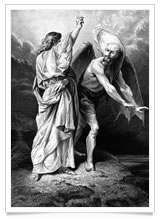by Rev. Jared Melius

The Transfiguration of Our Lord is the final crescendo of the season of Epiphany before the Church’s abrupt descent into Ash Wednesday and Lent. The earthly event is remembered as the greatest manifestation of our Lord’s glory while yet in His state of humiliation. Nevertheless, the Lord still has His greatest suffering and sacrifice before Him.
First, read Matt. 17:1–9 (especially 3–4). With whom are Moses and Elijah having a conversation?
_____________________________________
_____________________________________
Though he is “heavy with sleep” and not “fully awake” (Luke 9:32), Peter can overhear this conversation because Matt. 17:4 says, “And Peter answeredc and said to Jesus . . .” Somehow, the content of that heavenly conversation concerned Peter, at least inasmuch as he thought it necessary to respond.
Review Luke 9:28–31. What were Moses and Elijah discussing with Jesus?
_____________________________________
_____________________________________
The heavenly conversation concerned the exodus or “departure” of Jesus to be brought about in Jerusalem. They were talking about the sacrifice Jesus would pay in Jerusalem: the cross, the suffering, the redemption of the world.
If anyone stood to benefit by the conversation of the suffering and the cross, it is our Lord Himself. Though sinless, Jesus is still a man. He is subject to temptation and sorrow. He faces His task without a second thought, but the devil will not leave Him alone. The devil tempts Him to take His throne and glory without suffering (Matt. 4:8–11). He tempts Him to save Himself (Matt. 27:41–44). This temptation is real. It gives Jesus great anguish and sorrow. Why do you think Satan tempts Jesus to avoid the suffering of the cross?
_____________________________________
_____________________________________
Of course, the cross is Satan’s defeat. Thus, Satan tempts Jesus to make use of His rights as God and to forego the anguish of the atonement. In fact, it is very probable that Moses and Elijah are sent to Jesus on the mountain to encourage Him on His road to the cross, to point the way forward, to urge Him to go and purchase men’s souls with His blood.
Back to Peter. Until now, what does Peter think about the prospect of Jesus suffering and dying? Read Matt. 16:21–23, an event that happened only a week earlier.
_____________________________________
_____________________________________
On the mountain, when Peter hears more talk of suffering and dying, he has finally had enough. He thinks he will convince the Lord to reconsider, to stay on the mountain and enjoy the glory. He suggests building tabernacles to prolong the event. Peter likes the translucence of glory, but, more pointedly, he does not like the conversation of Jesus’ departure.
If the devil’s repeated attempts to thwart the Lord’s suffering are to be considered “temptations,” then Peter’s desire to detain Jesus on the mountain and away from Jerusalem was a temptation for Jesus as well. If a similar suggestion from Peter a week prior was rebuked by Jesus as coming from Satan (Matt. 16:22, 23), then shouldn’t this suggestion on the mountain also be considered satanic in origin?
_____________________________________
_____________________________________
What a sight to behold on this holy mountain! The heavenly counsel urges Jesus to ride on to the cross and purchase sinners for eternal life and salvation, while the very sinners in question, clouded by weakness, beset with fear, respond and urge Him to delay. Actually, not a single one of us urged Jesus to do what He did. And yet He did it anyway. He absolves Peter and James and John (Matt. 17:7). He comes down from the mountain (v. 9). He sets His face to go to Jerusalem (Luke 9:51).
—
> Did you know? This year, Transfiguration is observed either on March 6 (three-year series) or Feb. 13 (one-year series).
About the Author: Rev. Jared Melius is pastor of Mount Zion Lutheran Church, Denver, Colo.
February 2011




Pingback: SVLC DEVOTION SUNDAY, FEBRUARY 27 - Shepherd of the Valley Lutheran Church